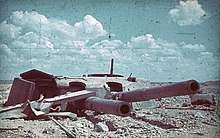Röchling shell
Röchling shells were bunker-busting artillery shells, developed by German engineer August Cönders during World War II, based on the theory of increasing the sectional density to improve penetration.[1]

Description
The fin-stabilised shells made from chrome-vanadium steel were able to penetrate much more than 4 metres (13 ft) of reinforced concrete roof before burying the shell through the floor and into earth.[2] However, these shells had a low muzzle velocity, and thus a high dispersion, 36 m (118 ft) on 1,000 m (3,300 ft) range. As a result, they saw very limited use during World War II; only about 200 shells were ever fired even though 6000 such shells were made for the very large howitzers like the 21 cm mortar.
Röchling shells were developed for the 21 cm Mörser 18, a captured French 34 cm railway gun 674(f), and the 35.5 cm Haubitze M1 only. In addition, many experimental HE shells were made for the 37 mm PAK and 50 mm PAK weapons.[3]
Use
Röchling shells were tested in 1942 and 1943 first against the Belgian Fort de Battice then against the Belgian Fort d'Aubin-Neufchâteau.[4][5] They were also tested against the fortresses of Hůrka,[6] Hanička and Dobrošov[7][8] (today's Czech Republic),[9] the Gössler wall, Toplitzsee (Austria) and at the Hillersleben test facility (Germany).
They were regarded as a German secret weapon, and there is speculation that their use was limited in order to reduce the chance of dud shells being recovered and exploited by the Allied forces.[10] A more likely reason, however, is their poor accuracy.[11]
Preserved small-size prototype of Röchling shell (36 cm long) is since 2020 exhibited in the Museum of Czechoslovakian fortifications[12], inside the fort Hůrka (cz). Remnants of full-sized test shells are still visible in the walls of the fort. [13]
See also
References
- "Das Röchling-geschoss". Waffen Revue (in German). 72. 1988. pp. 73–106.
- Georg, Friedrich (2005). Hitler's Miracle Weapons: The Secret History of the Rockets and Flying Crafts of the Third Reich Volume 2 - from the V-1 to the A-9; Unconventional Short- and Medium-Range Weapons. Helion Limited. p. 212. ISBN 9781874622628.
- "Die Roechlingranaten des Heeres". www.balsi.de. Retrieved 2016-08-03.
- "Premier obus flêchette". Les Canons de l'Apocalypse (in French). 30 December 2012. Retrieved 2016-08-03.
- Delacruz, Jean-Paul. "Les étranges obus du fort de Neufchâteau". Reliques:souterrains et industries (in French).
- "Artillery fort Hůrka – Röchling projectile embedded into the wall". Flickr. Retrieved 2016-08-03.
- Čermák, Ladislav. "Bunkry.cz – Protibetonové Granáty Röchling". www.bunkry.cz. Retrieved 2016-08-03.
- Čermák, Ladislav. "Bunkry.cz – Dělostřelecká tvrz Dobrošov". www.bunkry.cz. Retrieved 2016-08-03.
- Jiricek, Pavel; Foglar, Marek (2015-01-01). "Numerical simulation of the effect of regular and sub-caliber projectiles on military bunkers". EPJ Web of Conferences. 94. doi:10.1051/epjconf/20159404049. ISSN 2100-014X.
- Keegan, John (1990). Encyclopedia of World War II. Gallery Books. p. 212. ISBN 97 80831753504.
- War and Games. "V 3 – THE HIGH-PRESSURE PUMP GUN". Archived from the original on July 23, 2009. Retrieved 2009-12-15.
- Museum of Czechoslovakian fortifications (en)
- Czech language article about the newly exhibited Röchling shell